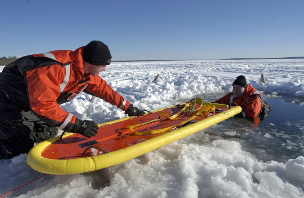With warm and rainy weather patterns seen in recent weeks in many parts of the state, the Michigan Department of Natural Resources urges ice anglers and snowmobilers to remember that no ice is safe ice.
“When temperatures reach into the 40s, as they have recently in many areas, thawing will occur and that will definitely weaken ice,” said Sgt. Steve Orange, DNR Law Enforcement Division’s recreational safety, education and enforcement supervisor. “It’s very important to know and follow guidelines to determine how ice looks and feels so that your day of ice fishing or snowmobiling is enjoyable and safe. Ignoring warning signs of weakened ice can result in a life-threatening incident.”
The DNR does not recommend the standard “inch-thickness” guide used by many anglers and snowmobilers to determine ice safety, because ice seldom forms at a uniform rate.
 Orange said a warm spell may take several days to weaken the ice; however, when temperatures vary widely, causing the ice to thaw during the day and refreeze at night, the result is a weak, “spongy” or honeycombed ice that is unsafe.
Orange said a warm spell may take several days to weaken the ice; however, when temperatures vary widely, causing the ice to thaw during the day and refreeze at night, the result is a weak, “spongy” or honeycombed ice that is unsafe.
Ice strength can’t be determined by its look, thickness, the temperature or whether or not it’s covered with snow, Orange said.
When venturing onto ice, remember:
- Clear ice that has a bluish tint is the strongest. Ice formed by melted and refrozen snow appears milky, and is very porous and weak.
- Ice covered by snow always should be presumed unsafe. Snow acts like an insulating blanket and slows the freezing process. Ice under the snow will be thinner and weaker. A snowfall also can warm up and melt existing ice.
- If there is slush on the ice, stay off. Slush ice is only about half as strong as clear ice and indicates the ice is no longer freezing from the bottom.
“Although it’s a personal decision, the DNR does not recommend ice anglers take a car or truck onto the ice,” Orange said.
Anyone venturing onto the ice is urged to wear a life jacket, wear bright colors, bring a cell phone and bring along a set of ice picks or ice claws, which can be found in most sporting goods stores.
If ice does break, Orange offered the following tips:
- Try to remain calm.
- Don’t remove winter clothing. Heavy clothes won’t drag you down, but instead can trap air to provide warmth and flotation. This is especially true with a snowmobile suit.
- Turn in the water toward the direction you came from; that is probably the strongest ice.
- If you have them, dig the points of the picks into the ice and, while vigorously kicking your feet, pull yourself onto the surface by sliding forward on the ice.
- Roll away from the area of weak ice. Rolling on the ice will distribute your weight to help avoid breaking through again.
- Get to shelter, heat, warm dry clothing and warm, nonalcoholic and noncaffeinated drinks.
- Call 911 and seek medical attention if you feel disoriented, have uncontrollable shivering or have any other ill effects that may be symptoms of hypothermia (the life-threatening drop in the body’s core temperature).
Learn more about ice safety on the DNR website.
Michigan conservation officers are fully commissioned state peace officers who provide natural resources protection, ensure recreational safety and protect citizens by providing general law enforcement duties and lifesaving operations in the communities they serve. Learn more about Michigan conservation officers atwww.michigan.gov/conservationofficers.
 Keweenaw Report Your Source for Local News and Sports
Keweenaw Report Your Source for Local News and Sports





